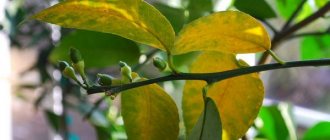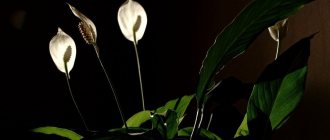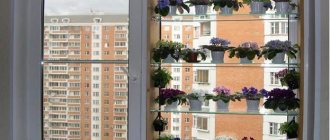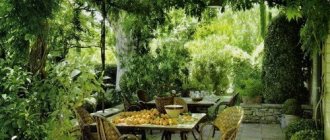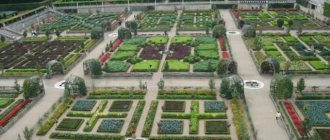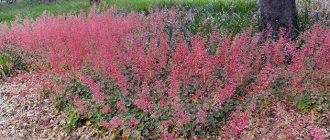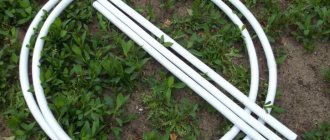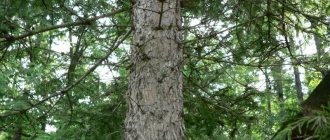Flowers, which require certain conditions to grow successfully, will help decorate your home and make it more comfortable. Artificial lighting for indoor plants plays a particularly important role in winter, when daylight hours are reduced and the flowers do not receive enough light for normal growth and development.
From this article you will learn how to properly make artificial lighting for indoor plants and what requirements light sources must meet.
- How to choose a lamp
- Peculiarities
Decorative lighting and lighting for plant growth
A lamp for growing indoor plants is a great way to extend daylight hours.
After all, many indoor flowers are of tropical origin, which means they experience a daily lack of solar energy, especially in winter. For effective plant growth, the daylight hours should be about 15 hours. Otherwise, they weaken, stop blooming and are susceptible to various diseases. When planning the future illumination of indoor flowers, it is important not to miss the aesthetic component. The phytolight should become part of the interior, a unique decorative element. There are a huge number of lamps on sale with wall mounts of different shapes, suitable for any energy-saving lamp: CFL or LED. Depending on the size of the home flower garden, lighting can be made from several spot lights aimed directly at each green pet, or from tubular fluorescent lamps with a reflector. Using your own imagination, you can make an original LED phytolight yourself.
How to place lighting lamps
When placing lamps, it is useful to know that if the distance to the lamp is doubled, the light intensity on the plant will decrease by four times.
If burn marks appear on the leaves, then the lamps are hung too low, elongated stems and pale leaves indicate that the light source is too far away.
With side artificial lighting, plants can bend their stems towards the light; it is better to add light from above.
The actual issue of landscaping a living space is not complicated. There are more than 500 species and varieties of indoor ornamental plants available for sale. Many books, magazine articles, and instructions have been written on this topic. However, almost all of them consider keeping plants in natural light, even in partial shade rooms. Based on this, plants are divided into light-loving and shade-tolerant.
In practice, as a rule, they do not think about this. When purchasing living plants, people treat them as floor lamps, vases or coffee tables, caring only about where they will look best. But this “ideal” place may not be suitable for the chosen plant. Then there it will be suppressed over time and die, primarily because lack of lighting is the main factor limiting its growth.
It is light that provides plants with the energy necessary for the synthesis of organic compounds.
With a lack of lighting, plants experience the disease chlorosis, which in the initial stages is tested for the following signs: leaves turn pale and become smaller, or grow in length but not in width; stems stretch; the water content of living tissues (turgor) decreases, the leaves droop; plants do not bloom or bloom with small pale flowers. In addition, plants become sensitive to all factors of external conditions: from the hardness of the water used for irrigation to drafts.
The main way to treat chlorosis is to increase lighting. And this is where artificial lighting comes to the rescue.
Artificial lighting of violets
The first official information about the use of artificial lighting dates back to the time of Louis XIV, under whom the Versailles greenhouse was built. For us, this time is comparable to the reign of Peter I’s elder brother, Tsar Fyodor Alekseevich. In France, the creator of the landscape park and garden of Versailles, A. Le Nôtre, used wax candles to illuminate the citrus trees in the greenhouse in winter.
According to chroniclers, oranges, oranges and tangerines bloomed there. In Russia, during the time of Catherine II, it was popular to build greenhouses and orange houses in parks and estates, the plants in which were also illuminated with numerous wax candles.
In English gardening literature there is a mention that plants in winter gardens were illuminated with gas lamps - lighting devices using gas.
So artificial lighting has been known for a long time. But, of course, a huge breakthrough in this area came with the discovery of electricity. Artificial electric lighting is the easiest and cheapest way to provide sufficient light to plants that do not receive the required amount of sunlight.
The most important component of growth is the light spectrum
In order to understand how inhomogeneous light is from different electrical sources and the sun, you need to look at their spectral composition. The spectral characteristic is the dependence of the radiation intensity on the wavelength. The solar radiation curve is continuous throughout the visible range with a decrease in the UV and IR regions. The spectrum of artificial light sources in most cases is represented by individual pulses of different amplitudes, which as a result gives the light a certain hue.
During the experiments, it was found that for successful development, plants do not use the full spectrum, but only its individual parts. The following wavelengths are considered the most vital:
- 640–660 nm – velvety red color, necessary for all adult plants for reproductive development, as well as for strengthening the root system;
- 595–610 nm – orange for flowering and fruit ripening;
- 440–445 nm – violet color for vegetative development;
- 380–400 nm – near UV range to regulate the rate of growth and formation of proteins;
- 280–315 nm – mid-UV range to increase frost resistance.
Lighting with only the listed rays is not suitable for all plants. Each representative of the flora is unique in its “wave” preferences. This means that it is impossible to fully replace the sun's energy using lamps. But artificial lighting of plants in the morning and evening hours can significantly improve their life.
Flower lighting in winter
In cold weather, the period of time for illumination is extended. In winter, the choice of lighting device is approached not only based on the required illumination, but also taking into account temperature characteristics. Some plants bloom at certain temperatures, others at completely different temperatures. Plants that love warmth can survive in winter with very low amounts of heat and light. For other colors, lighting is important. They are illuminated for 12 hours - in the morning and evening, since they receive less sunlight.
Key Features
The flower itself is of great importance in organizing lighting. You need to find all the information about him and only after that you can select what will suit him. Any flower has its own specific characteristics, which must be taken into account. The main work is to ensure that there is a lack of sunlight.
You need to know exactly the seasonal norms. This will determine the effectiveness of the light. Proper lighting will stimulate growth and it will be visible.
Lighting for orchids in winter
For orchids you need to create a special climate, since these flowers grow in exotic countries. It's warm and sunny there. The optimal illumination indicator for these colors is a level from 10,000 to 30,000 Lux. Some types of orchids may need 15,000 lux.
You should not use conventional solutions as light bulbs. It is better to buy a phytolamp. This will avoid burns to the top and bottom leaves.
The most important condition when lighting orchids is that the lamp should not get hot. Ideally, your hand will not feel any heat at a distance of 10 cm from the plant. The distance from the lamp to the flower should be between 10 and 50 cm. This depends on the power of the lamp. So, for 10 cm, a light bulb is placed in the device, producing 7000 Lux. For a distance of 10 cm you need 5200 Lux. For 50 cm you will need 1700 Lux. The backlight duration is on average 12 hours.
LED strip lighting
This option is the most optimal. The tape is easy to attach anywhere and its light is very suitable for plants. The tape is cut to size with scissors and glued to a suitable surface. The LED spectrum leads to accelerated plant growth. Take a look at the photo - this is LED lighting.
You can also glean interesting and useful data from the article. In the comments you can write how and who has organized such lighting, you can attach a photo. This will be useful to many.
How to choose a lamp for plants (2 videos)
Various lamps and lighting options (40 photos)
Signs of lack of light
There are a number of signs by which it is easy to identify a lack of light. You just need to take a close look at your flower and compare it with the standard. For example, find a similar view on the Internet. A clear lack of illumination manifests itself as follows. The plant slows down its growth. The new leaves are smaller and the stem becomes thinner. The lower leaves turn yellow. The flower either stops blooming completely, or the number of buds formed is less than the statistical average. It is assumed that watering, humidity and air temperature are normal.
Installation of a lighting fixture
Placing a lamp over a pot
Another important point in illuminating indoor flora is the correct placement of the light source. One rule applies here: when the distance from the lamp to the pot increases by 2 times, the intensity of the light flux and its effect on the plant will decrease by 4 times.
The distance can be selected experimentally:
- when burn marks appear on the sheet plate, move the lamp away;
- when the shoots lengthen, the lamp is brought closer.
These manipulations are done until the optimal effect is achieved. Having found the optimal distance, it is not recommended to move the pot and lamp so as not to upset the “settings”.
How much light do you need?
It is impossible to give a definite answer to this question. Just as a person can live in different parts of the globe, so an indoor flower can grow on a windowsill facing north, south, west or east. Throughout its life, the plant will strive to adapt to current conditions: stretch upward due to lack of light or, conversely, expose the next blossoming bud to the sun’s rays.
By observing the appearance of the stems and leaves, the size and number of flowers, you can determine the adequacy of the lighting level. At the same time, do not forget about what stage of development the indoor flower is at: growing season, flowering, seed ripening. At each stage, it takes light from the sun of the wavelength that it needs at the moment. Therefore, when organizing additional lighting, it is important to take into account the qualitative component of the light flux.
Long-term exposure to bright light from the sun and lamps with an illumination level of more than 15 thousand lux is favored by those indoor flowers that grow in the open air in their natural habitat. These are many people's favorite crassula, geranium, kalanchoe, and begonia. Artificial lighting for plants of this type in the evening will benefit them.
Representatives of the flora that feel comfortable in illumination of 10–15 thousand lux include spathiphyllum, clivia, saintpaulia, tradescantia and dracaena. The leaves of these types of indoor flowers do not like hot sunlight, but also do not tolerate early twilight. Therefore, the ideal place for them would be a window sill with access to the west, where in the evening their leaves will receive the necessary energy from the setting sun.
So-called shade-loving plants can bloom and develop away from the window opening, being content with illumination of up to 10 thousand lux. However, this does not mean that they will die if they are placed in a brighter place. They just need less direct sunlight. These include some types of ficus and dracaena, philodendron, as well as tropical vines.
How to increase illumination
When looking for a place for a lamp, remember an important rule: illumination decreases greatly with distance. By doubling the distance between the lamp and the plant, we will give it only a quarter of the original amount of light. Lighting is most effective if the rays fall on the illuminated object perpendicular to the surface. Since the leaves of most indoor flowers are located horizontally, the source should shine as strictly from top to bottom as possible.
There is a way to significantly increase the illumination of a surface while maintaining all the parameters of the light source. Using a reflector allows you to increase light output by up to 50%. The principle of operation of this device is to reflect upward and sideways light from the lamp down to the plants. Point light sources (incandescent, energy-saving and gas-discharge lamps) are most often equipped with a conical or elliptical reflector, and fluorescent tubes are U-shaped. White matte surfaces reflect light best, not mirrors, as we used to think.
Often reflectors are provided with lamps in which a light source is installed. For halogen incandescent lamps and high-pressure discharge lamps, the reflectors may be contained in the bulb itself. You can make a simple reflector yourself from foil and tin. But remember that it must be fireproof and provide for heat removal from the lamp.
You can complete the creation of a home artificial light system using electric timers, designed in the form of an adapter: the device is plugged into an outlet, and the lamp cord is connected to it. A timer with a mechanical programmer is much cheaper than an electronic one, but is not as easy to use. The latter's microcomputer allows you to program the lamp on/off with an accuracy of up to a minute for a week or month in advance, and you can set different lighting modes on different days.
When choosing a light source, pay attention to the type and electrical power of the lamp - they determine the intensity of the glow. The color richness of the spectrum is also very important: for successful growth and flowering, plants need the red and blue components of sunlight. The human eye is adapted to perceive yellow and green rays. A bright lamp, from our point of view, may well turn out to be dim for an indoor flower or seedling.
Lighting characteristics are presented in the table below (
e)
Supplementary lighting for plants and artificial lighting sources
In most cases, indoor plants need additional lighting. Flowers, which at first glance have bright green succulent leaves and bloom regularly, will look even better if they are exposed to a phytolamp. If someone thinks otherwise, then he has an excellent chance to be convinced of the error of his thinking and assemble a phyto-lamp with his own hands. To extend daylight hours, various sources of artificial light are used. Let's look at each of them and figure out which light is best for plants.
Incandescent lamps
Illuminating plants with incandescent lamps is the least effective for several reasons. The emission spectrum of conventional light bulbs with a spiral is strongly red-shifted, which does not contribute to photosynthesis in any way. Low efficiency and, as a consequence, enormous heat generation drive their energy and light efficiency to zero. In addition, incandescent lamps have the shortest service life compared to other artificial light sources.
Fluorescent lamps
Tubular fluorescent or, as they are most often called, energy-saving fluorescent lamps of the T8 full spectrum type (T = 5300–6500°K) are considered the best option for illuminating indoor plants for many years.
They have earned many positive reviews due to the presence of a selective spectrum, efficiency and low heat transfer combined with reasonable cost. Companies specializing in the production of fluorescent lamps offer plant growers an improved option - a phytolamp with a selective emission spectrum. They work predominantly in the blue and red range, as can be seen from the characteristic glow. But the cost of such lamps for illuminating plants is an order of magnitude higher than their conventional counterparts.
DNAT
A sodium lamp is the most efficient light source. In terms of luminous efficiency and working life, these lamps are comparable to LEDs for plants. But they are not suitable for home use due to their excessively high brightness (more than 15 thousand lux). But in many greenhouses and conservatories, growing plants under artificial lighting is based precisely on gas-discharge lamps. Due to the fact that they emit more red light, they are installed in combination with 6500K fluorescent lamps.
LED light sources
All LED phytolights are divided into three groups:
- bicolor;
- with multispectrum;
- with full spectrum.
Bicolor or two-color lamps are based on blue (440–450 nm) and red (640–660 nm) LEDs. Their light is considered to be the most optimal for organizing illumination of any plants during the growing season. This working spectrum favors the process of photosynthesis, which leads to accelerated growth of green mass. That is why summer residents prefer blue-red LED lamps when growing vegetable seedlings on the windowsill.
LED lamps with a multispectrum have a wider application due to the expansion of the red range into the region of infrared and yellow light. They are in demand for illuminating adult plants, stimulating flowering and fruit ripening. In apartment conditions, it is better to use LED multispectrum for flowers with a dense crown.
A phytolight with a full spectrum of radiation can be used to illuminate flowers in an apartment, regardless of the type and location. This is a kind of universal artificial light source that emits over a wide range with maximums in the red and blue zones. The full spectrum LED lamp is a tandem of energy efficiency and light energy reminiscent of the action of sunlight.
Today, the creation of favorable conditions for a widespread transition to phyto-LEDs is not happening for two reasons:
- high cost of high-quality lamps for plants;
- a large number of fakes based on conventional LEDs.
Types of lamps
To provide normal additional lighting or to completely illuminate a houseplant in an apartment, several types of light bulbs are used. These are traditional incandescent lamps, halogen, LED lamps, lamps, LED strip. Let's consider their characteristics and features.
Incandescent lamp
This is the most common type, which everyone is familiar with - there are or were such lamps in every apartment. Due to electrical energy, the tungsten spiral, which is located in a glass container, is heated. The device is screwed into the socket, and no special equipment is required for connection.
The disadvantage is the fact that there is no blue color in the spectrum. The light output is very low and amounts to 17-25 Lm/W. This is not the best choice for indoor plant lighting. The lamp gets very hot and if placed above flowers even at a height of 1 m, it can cause burns. If you raise the lamp more than 1 meter, the lighting efficiency will tend to zero.
Luminescent
A fluorescent lamp is a bulb with electrodes on each side. They are connected by a tungsten helix. Inside the tube there are inert gases or mercury vapor. A special layer of phosphor is applied to the inner surface of the flask.
This is what a fluorescent lamp looks like
There are three types of such lamps:
- general purpose products;
- special purpose;
- compact models.
The general-purpose model has good characteristics - high light output, low heat emission, and long service life. In plant growing, they are used to organize additional illumination of indoor plants when the daylight hours are short. But the main thing about these lamps is their very limited spectrum. It is not recommended to use paws for constant lighting.
Special-purpose fluorescent lamps are distinguished by the presence of a phosphor layer. Due to this improvement, the spectrum of the lamp is very similar to that needed for plants. This lamp can be selected in cases where it is necessary to provide full illumination and periodic additional illumination. Also, these lamps are often chosen for creating decorative lighting with your own hands.
The disadvantages include the inflated cost and an electronic ballast installation, without which it will not be possible to connect the device to the network. The lamp can provide the right light, but it is recommended to use it only when there are no other devices with a power of 200-300 W.
Gas discharge
These products are capable of generating the brightest light. There are several types of these lamps; mercury, sodium, and metal halide can be distinguished. Mercury models are among the very first. There is no special coating on the inside of the bulb, and the light output coefficient is very low. They emit light with a bluish tint that is unpleasant both for the human eye and for green friends.
Updated models with improved spectral characteristics are now being produced. They have become one of the lighting options for greenhouses and greenhouses. But the problem with heat transfer has not yet been solved.
Sodium models have greater brightness; these are effective models with high light output and long service life. The spectrum is in the red zone. With two lamps you can illuminate a huge area in the winter garden or a large collection of plants. To ensure balance in the spectrum, it is recommended to alternate mercury and halogen models. Green plants will be happy.
Article on the topic: Chandeliers in the interior of different styles: help in choosing (+130 photos)
Metal halide light bulbs are the most advanced devices for lighting home plants, as well as greenhouses and greenhouses. They differ in the following characteristics:
- high power;
- high service life;
- optimal spectral balance.
To use such light bulbs in your home, you will need to purchase a special socket. There is also one big drawback of such lamps - the cost. It is significantly higher than the price of basic analogues.
What light is best for growth?
Of course, the ideal light source is solar energy. In apartments with windows facing southeast and southwest, you can grow any flowers, placing them in different parts of the room. But don’t be upset for those who only have a north-facing view from their window. Fluorescent and LED lamps for lighting plants compensate for the lack of sun rays.
Fluorescent lamps for plants are a time-tested budget option. They are suitable for those who are trying to create normal conditions for a flower with little investment. LED phytolamps are for those who want to speed things up and achieve the best results in a short time, despite the price of several thousand rubles.
Choosing lighting fixtures
The lamp with which the home flora will be illuminated is chosen quite carefully. This is primarily due to the fact that lamps in this situation will not be able to create the optimal level of illumination for each flower. But there are some universal points here.
Lamps for plant lighting
For all colors, the daylight spectrum is optimal. It ranges from ultraviolet, through visible and to infrared rays. At the same time, lamps, as artificial light sources, can create light in one spectrum or another, reminiscent of natural light.
Note! Chlorophyll, as the main component of the light-sensitive system of plants, absorbs light most in the blue or red parts of the spectrum.
Light spectrum
However, they do not have the same effect on the flower:
- if the lamp lights up red, then the flower will increase its green mass;
- If the lamp lights up with blue-violet light, the time of fasting of shoots and seed germination accelerates.
It is important to know this so that the lamps provide the light needed in a given situation. Today, the following can be used as a light source for illumination:
- LED lamp or strip. If a light bulb is used, it must be screwed into an appropriate lighting fixture. And the LED strip can be placed independently on furniture or even on the wall. An LED lamp may contain a light source of different spectrum powers. It is best if such a lamp or strip produces blue or red light.
Note! LED strip is the best option in a situation where the lamp will be made by hand. This tape is based on a self-adhesive base, thanks to which it can easily be attached to the base of the lamp. In addition, the LED strip can also be attached to the bottom surface of hanging cabinets. At the same time, the tape can change its light from red to blue, depending on the need, which is very convenient.
LED flower lighting
- fluorescent and gas discharge lamp. Such light sources are inferior to LED products in terms of electricity consumption, as well as technical characteristics of light. But they are still often used to illuminate indoor plants.
Fluorescent illumination of flowers
- incandescent lamp. It is rarely used, as it does not allow saving on electricity.
As you can see, the most advantageous light source here is an LED strip or lamp.
Which device do you prefer?
To ensure the desired level of illumination, you need to choose the right special source that will help prevent all of the above consequences. The range of lighting devices on the market is very wide, which allows you to find the ideal option in all respects:
- Using only standard incandescent elements is not enough for the proper functioning of intracellular processes, since their emission spectrum does not contain blue, violet colors, and infrared waves cause the stems to stretch excessively, overheating them and drying out the foliage.
- The power of the lamp is calculated based on the area of plantings that are planned to be illuminated.
- The design should be convenient for placement. You can choose from wall-mounted, floor-mounted, tripod-mounted, and suspended units.
- Based on the type of vegetation, the lighting device should be chosen with or without a diffuser, reflector.
- An important aspect is the percentage of spectral radiation.
- For ease of use, the device is equipped with a mechanical or electronic timer.
To save money, you can make artificial lighting yourself. This will make it possible to use energy-saving, cheap elements. To do this, you will need to assemble components with a power of 3 W in the following quantities: blue - 4 pcs., red - 10 pcs., white - 1 pc., green - 1 pc.
They need to be attached to the aluminum heatsink plate using thermal paste. By soldering, the diodes are connected one by one, then mounted to the driver. It is recommended to install a small fan on the reverse side.
Lighting devices that have red and blue tones within the spectral range are divided into several types.
Incandescent lamps, powered by tungsten filaments, are not the best option, as they produce too little light energy and heat up excessively, which leads to negative consequences, for example, thermal burns. Another disadvantage is the overestimated percentage of red rays and the lack of blue, necessary for photosynthesis inside the foliage. Despite the low cost, this type consumes a lot of electricity, which contributes to unnecessary costs later.
Fluorescent lamps
Widely distributed and popular among the field of artificial lighting for plants. There are several varieties: general purpose, delivering power up to 70 W. This skin is ideal for short-term use. The main characteristic is the low emission spectrum. Special purpose devices are slightly weaker - from 35 to 50 W.
They are considered the most acceptable option for lighting both on a permanent basis and periodically. The color spectrum of these lamps is found in accordance with acceptable limits. Compact design delivers up to 20 watts.
Suitable for occasional lighting. Fluorescent lamps, unlike the previous type, practically do not heat up, so they are much safer for placement above plants. Another undeniable advantage is their low level of energy consumption.
When thinking between a daylight device and a specialized phytolamp, preference should be given to the second option. This type is covered with glass, providing the desired emission spectrum, closest to natural sunlight. It is worth noting that directed flows increase productivity by 15-25%.
Energy-saving lamps
The principle of operation is similar to fluorescent ones, but they are more compact and convenient to use. The amount of energy expended is significantly lower than that of previous options. Their service life is much longer - up to 15 thousand hours.
The spectral blue emitted by this type of lamp will be the best option for non-flowering plants. There are several types: cold - increases the speed of germination of greenery, accelerates production during the vegetative period, warm is suitable for the active phase of inflorescence formation, daytime is used at any time.
Sodium lamps
They are the most effective and economical. The average service life varies within 20 thousand hours of continuous use. One lamp will be enough to illuminate an area up to 1.5 m in size. The main colors in the spectral range are orange, red, and blue. This combination allows you to significantly speed up the process of growth and appearance of inflorescences.
Despite these advantages, sodium lighting devices have several drawbacks, including high cost and large dimensions. Most often used in winter and botanical gardens and greenhouses. An important point is their disposal, since the device contains mercury and sodium, which require compliance with safety rules.
LED lamp
It is the most modern type of artificial lighting. The more common name is LED. This type has a number of advantages, of which the most important are low energy consumption and long service life, providing up to 50,000 hours of uninterrupted operation. A variety of shapes, including adhesive tapes, and sizes will allow you to choose the best option for your needs.
They are environmentally friendly and safe for both plants and the human body. The radiation spectrum includes exclusively red, blue, and orange waves, which have a beneficial effect on the development and growth of flowers. It is necessary to calculate the lighting power according to the following principle - for 1 sq. m of area will require at least 400 W.
Another advantage of LED lamps is that they practically do not emit heat, and this allows them to be placed in close proximity to the illuminated object. The view provides the plantings with the maximum level of comfort and the correct range of rays. The color of the lighting directly depends on the crystal installed inside, which is a conductor of electric current. It is possible to adjust power and intensity.
This is done by decreasing or increasing the current. Several crystals are included inside the structure, reproducing certain gamuts of radiation, which makes it possible to influence flowers differently at different periods of their life.
Metal halogen lamps
The emission spectrum is closest to natural. Red rays have a beneficial effect on buds and inflorescences. The downside is their high cost. Induction devices are similar in principle to luminescent devices, but the design is different. These lamps do not contain electrodes inside. This nuance allows you to significantly extend their service life to 60 thousand hours or 20 years.
The brightness distinguished by this species decreases slightly over time - to a maximum of 5%. A significant advantage is that they are not afraid of sudden changes in voltage, do not blink during operation, and do not cause discomfort to the eyes.
They do not heat up during operation, which allows the element to be placed fairly close to the illuminated colors. Induction lamps can be used as the only source, thanks to the radiation spectrum that is extremely close to the natural spectrum.
Relocatable, convertible and versatile products are distinguished by the fact that both a metal halide and similar high pressure sodium lamps can be placed inside. This species is widespread among gardeners.
It allows you to adjust the method of exposure to plants at different cycles of their maturation. During the growing season, a halogen lamp is installed, then, when fruits begin to form, you need to exchange it for sodium or mercury. To switch, you only need to change the flask and set the appropriate mode.
Which color is best for plants?
However, as it turned out, the efficiency of a light bulb is not the main thing in the proper cultivation of plants. The most important thing is their spectrum and how different it is from natural solar radiation. After all, all flowers, vegetables, fruits, and berries are accustomed to it.
What is hidden behind such a scientific name as the emission spectrum? To understand this, you have to remember what light is? And light is nothing more than an electromagnetic wave.
Moreover, each color has a certain wavelength, hence the rainbow. However, different lengths mean not only different colors, but most importantly, different amounts of energy.
Waves with shorter wavelengths contain more energy.
If all the colors are conventionally represented not in the form of the usual straight line, but in the form of balls, then the blue ball will be the largest in size. Green is smaller, and red will be the smallest.
All colors are always simplified to these three types of RGB:
- red
- green
- blue
Why is the blue ball the most voluminous? Because its wavelength is the shortest. It is smaller than green. And green, in turn, has less than red.
As a result, it turns out that red carries the least energy, and blue carries the most.
And here many may have a logical question: “Is there a difference in which spectrum to illuminate the plants?” And if there is, can this knowledge be somehow used for business?
After all, if some color turns out to be more effective, then there is nothing easier than directing all the energy to the plant only from it. If blue is the boldest color, it is enough to illuminate the plants only with it and get a great harvest all year round.
However, everything turns out to be not so simple. Here you need to take into account one more characteristic of light - its qualitative or spectral composition.
Groups of plants according to light needs
Based on the amount of light required, indoor plants can be divided into 2 main groups: light-loving and shade-tolerant, content with moderate lighting.
There is also an intermediate group - plants that prefer partial shade. This group includes only some species of light-loving or shade-tolerant genera. A striking example is Aglaonema, the natural species of which grow in forests and are therefore shade-tolerant. However, variegated (“variegated”) varieties prefer diffused light, without which they may lose their original color.
IN THE PHOTO: Variegated Aglaonema does not tolerate light deficits as easily as species with monochromatic leaves
The first group includes desert plants - Sedum, cacti, Haworthia, Hoya, Gasteria, Coleus, Croton, Eucalyptus. The second group includes Ivy, Dracaena fragrant, Saxifraga, Monstera, Aspidistra, Begonia.
You can even determine which group a particular plant belongs to visually. Just take a close look at it. Thus, shade-tolerant species are dark green in color, their leaves are wide, matte, and sometimes quite dense. The shoots of such plants are long, most often thickened. Light-loving species, on the contrary, have light green, equilateral, narrow and shiny leaves, often hard and thin. The shoots are short, with hairs.
IN THE PHOTO: Kleinia loves to bathe in the sun
As for the so-called “shade-loving” species, not a single flowering plant likes shade. But their “younger” brothers (although evolutionarily they are more like “grandfathers and grandmothers”) - mosses, lichens and ferns prefer the shade, because exposure to light can cause burns. Therefore, shade-loving plants are classified as a separate, less common group with their own specific conditions.
You can determine which group of plants your particular flower belongs to by visiting our Encyclopedia. The “Illumination” characteristic is indicated by a “sun” icon. Point it at it and you'll know how much light your plant needs.
Benefits of using phytolamps
For each type of indoor plant, there are recommendations for optimal care and maintenance parameters. Some feel more comfortable in shaded areas, while others require bright light for most of the day. Optimal living conditions can be ensured with the help of artificial lighting. There are many advantages to this solution:
• it is possible to organize an ecosystem, the characteristics of which are as close as possible to natural habitat conditions, for any type of plant;
• high efficiency of the photosynthesis process;
• active development of the root system, providing conditions for flowering and fruiting;
• creating conditions for the production of phytohormones that affect the life of the plant (their growth, protective properties).

